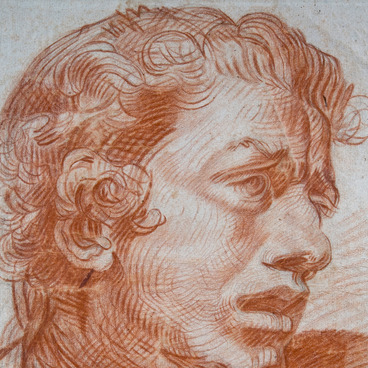This portrait of Arzamas Merchant Sitnikov was made by an unknown artist of the first provincial art school of Alexander Stupin. As a rule, it is impossible to identify paintings of painters that studied in this school because they were serfs.
The memories of Pyotr Kornilov, a bibliophile and art collector, survived to our time. He wrote that the Alexander Stupin Art School was the only source of artistic knowledge for serf talents in the early 19th century. Most of their works are still unidentified. Serfs did not have many civil rights, including the right of authorship, and thus they couldn’t sign their own work.
The Alexander Stupin Art School lasted for 45 years. Famous painters such as Vasily Perov, Evgraf Krendovsky, Ivan Zaitsev, Vasily Raev and other painters who participated in the creation of the Society for Travelling Art Exhibitions studied there.
Merchantry, a half-privileged Russian social class, was widespread in Arzamas from the 18th to early 20th century. It was considered the third class after nobility and clergy. Merchants made notable contributions to the architectural treatment of Arzamas, as well as its municipal improvement and economic growth. The range of famous merchants includes, but is not limited to Bebeshins, Budypins, Vyazovovs, and Zhevakins. The Arzamas Museum holdings include materials about the social life of merchants, as well as their commercial and social activities. Household stuffs, documents, photos, clothes, furniture, books, printed music and account books are among them.
However, merchants without the fortune of millions also carried on their business in Arzamas. They managed to make a significant contribution towards the city’s development, particularly by participating in charitable events and building of temples. Merchants spared no expense to support almshouses and the development of health and education.
The memories of Pyotr Kornilov, a bibliophile and art collector, survived to our time. He wrote that the Alexander Stupin Art School was the only source of artistic knowledge for serf talents in the early 19th century. Most of their works are still unidentified. Serfs did not have many civil rights, including the right of authorship, and thus they couldn’t sign their own work.
The Alexander Stupin Art School lasted for 45 years. Famous painters such as Vasily Perov, Evgraf Krendovsky, Ivan Zaitsev, Vasily Raev and other painters who participated in the creation of the Society for Travelling Art Exhibitions studied there.
Merchantry, a half-privileged Russian social class, was widespread in Arzamas from the 18th to early 20th century. It was considered the third class after nobility and clergy. Merchants made notable contributions to the architectural treatment of Arzamas, as well as its municipal improvement and economic growth. The range of famous merchants includes, but is not limited to Bebeshins, Budypins, Vyazovovs, and Zhevakins. The Arzamas Museum holdings include materials about the social life of merchants, as well as their commercial and social activities. Household stuffs, documents, photos, clothes, furniture, books, printed music and account books are among them.
However, merchants without the fortune of millions also carried on their business in Arzamas. They managed to make a significant contribution towards the city’s development, particularly by participating in charitable events and building of temples. Merchants spared no expense to support almshouses and the development of health and education.

